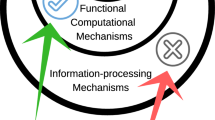Summary
This paper deals with three issues. First, the symbol-manipulation versus connectionism controversy is discussed briefly. Both can be seen as formalisms or languages for describing human behavior, but it is argued that these languages are not fully equivalent. The importance of the ability of connectionist models to learn autonomously, often underestimated, allows them to perform tasks that may defy formalization. Secondly, the structural and functional characteristics of a new connectionist learning model are presented. It avoids some of the psychological and biological implausibilities of currently popular models and solves some of the problems and shortcomings of these models. Thirdly, some simulation results are presented. The model successfully simulates the dissociation between explicit and implicit memory performance as found in patients with anterograde amnesia. This simulation provides an example of the advantages of using the connectionist language in the domain of memory psychology. It is also a good example of how psychological evidence can be used to improve connectionist models.
Similar content being viewed by others
References
Bechtel, W. (1985). Contemporary connectionism: Are the new parallel distributed processing models cognitive or associationist?Behaviorism, 13, 53–61.
Carpenter, G. A., & Grossberg, S. (1988). Neural dynamics of category learning and recognition: Attention, memory consolidation, and amnesia. In J. L. Davis, R. W. Newburgh, E. J. Wegman (Eds.),Brain structure, learning, and memory Boulder, Co.: Westview Press, AAAS Symposium series.
Cleeremans, A., Servan-Schreiber, D., & McClelland, J. L. (1989). Finite state automata and simple recurrent networks.Neural Computation, 1, 372–381.
Craik, F. I. M., & Lockhart, R. S. (1972). Levels of processing: A framework for memory research.Journal of Verbal Learning and Verbal Behavior, 11, 671–684.
Creutzfeldt, O. D. (1977). Generality of the functional structure of the neocortex.Naturwissenschaften, 64, 507–517.
Crick, F. H. C. (1979). Thinking about the brain.Scientific American, 241, 181–188.
Dennett, D. (1979).Brainstorms: Philosophical essays on mind and psychology. Sussex: Harverster Press.
Elman, J. L. (1989). Structured representations and connectionist models.Proceedings of the 11th Annual Conference of the Cognitive Science Society. Hillsdale, NJ: ErIbaum.
Feldman, I. A., & Ballard, D. M. (1982). Connectionist models and their properties.Cognitive Science, 6, 205–254.
Graf, P., & Mandler, G. (1984). Activation makes words more accessible, but not necessarily more retrievable.Journal of Verbal Learning and Verbal Behavior, 23, 553–568.
Hopfield, J. J., & Tank, D. W. (1986). Computing with neural circuits: A model.Science, 233, 625–633.
Jordan, M. I. (1986). Serial order: A parallel processing approach. Technical Report, Institute for Cognitive Science, University of California, San Diego.
Kihlstrom, J. F. (1987). The cognitive unconscious.Science, 237, 1445–1452.
Kuperstein, M. (1988). Neural model of adaptive hand-eye coordination for single postures.Science, 239, 1308–1311.
Levelt, W. J. M. (1989). De connectionistische mode: Symbolische en subsymbolische modellen van her menselijk gedrag. In C. Brown, P. Hagoort, & T. Meijering (Eds.),Vensters op de geest, (pp. 202–219). Utrecht: Stichting Grafiet.
Lorenz, E. N. (1963). Deterministic nonperiodic flow.Journal of Atmospheric Science, 20, 130–141.
Maas, H. J. L., van der, Verschure, P. F. M. J., & Molenaar, P. C. M. (1990). A note on chaotic behavior in simple neural networks.Neural Networks, (in press).
Marshall, J. C. (1989). An open mind?Nature, 339, 25–26.
Massaro, D. W. (1988). Some criticism of connectionist models of human performance.Journal of Memory and Language, 27, 213–234.
McClelland, J. L., & Rumelhart, D. E. (Eds.) (1986).Parallel distributed processing (Vol. 2). Cambridge, MA: MIT Press.
Murre, J. M. J., Phaf, R. H., & Wolters, G. (1989). CALM networks: A modular approach to supervised and unsupervised learning.IEEE-INNS, Proceedings of the International Joint Conference on Neural Networks, June 1989, Vol. 1, pp. 649 – 656.
Murre, J. M. J., Phaf., R. H., & Wolters, G. (in preparation). CALM: Categorizing and learning module.
Phaf, R. H., & Murre, J. M. J. (1989). Cognitive onder de microscop. In C. Brown, P. Hagoort, & T. Meijering (Eds.),Vensters op de geest, (pp. 164–201). Utrecht: Stichting Grafiet.
Phaf, R. H., Posrma, E. O., & Wolters, G. (1990). ELAN-1: A connectionist model for implicit and explicit memory tasks. In preparation.
Prince, A., & Pinker, S. (1988). Rules and connections in human language.TINS, 11, 195–202.
Raaijmakers, J. G. W., & Shiffrin, R. M. (1981). Search of associative memory.Psychological Review, 88, 93–134.
Reilly, R. (1989). On the relationship between connectionism and cognitive science.Irish Journal of Psychology, 10, 162–187.
Richardson-Klavehn, A., & Bjork, R. A. (1988). Measures of memory.Annual Review of Psychology, 39, 474–543.
Roorda-Hrdlickova, V., Wolters, G., Bonke, B., & Phaf, R. H. (1990). Unconscious perception during general anaesthesia demonstrated by an implicit memory task. In B. Bonke, W. Fitch, K. Millar (Eds.),Memory and awareness in anaesthesia (pp. 150–155). Amsterdam: Swets & Zeitlinger.
Rumelhart, D. E., & McClelland, J. L. (Eds.) (1986a).Parallel distributed processing (Vol. 1). Cambridge, MA: MIT Press.
Rumelhart, D. E., & McClelland, J. L. (1986b.). On learning the past tenses of English verbs. In J. L. McClelland, & D. E. Rumelhart (Eds.),Parallel distributed processing (Vol. 2, pp. 216–271). Cambridge, MA: MIT Press.
Schacter, D. L. (1987). Implicit memory: History and current status.Journal of Experimental Psychology: Human Learning and Memory, 13, 501–518.
Skarda, C. A., & Freeman, W. J. (1987). How brains make chaos to make sense of the world.Behavioral and Brain Sciences, 10, 161–195.
Squire, L. R., & Cohen, N. J. (1984). Human memory and amnesia. In J. McGaugh, G. Lynch, & N. Weinberger (Eds.),Proceedings of the conference on the neurobiology of learning and memory (pp. 3–64). New York: Guilford Press.
Szentágothai, J. (1975). The “module-concept” in cerebral cortext architecture.Brain Research, 95, 475–496.
Warrington, E. K., & Weiskrantz, L. (1970). Amnesia: Consolidation or retrieval.Nature, 217, 972–974.
Wolters, G. (1984). Memory: Two systems or one system with many subsystems?Behavioral and Brain Sciences, 7, 256–257.
Author information
Authors and Affiliations
Additional information
The second author is supported by the Dutch Organization for Scientific Research (NWO)
Rights and permissions
About this article
Cite this article
Wolters, G., Phaf, R.H. Implicit and explicit memory: Implications for the symbol-manipulation versus connectionism controversy. Psychol. Res 52, 137–144 (1990). https://doi.org/10.1007/BF00877521
Issue Date:
DOI: https://doi.org/10.1007/BF00877521




